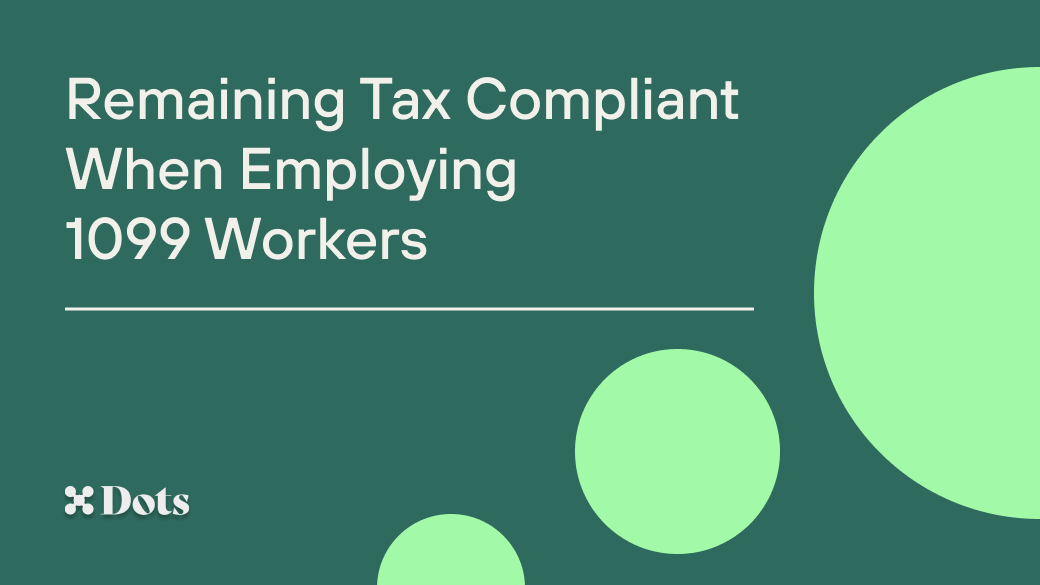Remaining Tax Compliant When Employing 1099 Workers

If you’re a business that employs freelancers and independent contractors, it’s essential to stay tax compliant. Improperly classifying employees or failing to file the correct tax documents can lead to hefty fines and penalties. To stay compliant, you need to understand your obligations as an employer and ensure you’re following the relevant state and federal laws for 1099 workers.
In this blog post, we’ll provide you with a guide to staying tax compliant when paying your contractors. If you’re looking for an easy way to automate tax compliance for 1099 worker payouts, make sure to schedule a demo with Dots. In the meantime, read on below to learn more.
What is the Difference Between an Independent Contractor and a W-2 Employee?
Before diving into the details of tax compliance, it’s important to understand the difference between an independent contractor and a W-2 employee. Here’s a quick definition of each:
- Independent contractor - An independent contractor is a person or business that provides services to another person or business without being employees of a company. They are typically self-employed and receive payments for the services they provide. Independent contractors are responsible for paying their own taxes and providing their own benefits. They are also sometimes referred to as freelancers, gig workers or 1099 workers.
- W-2 Employee - A W-2 employee is the traditional definition of an employee. These employees are employed by a company and they receive wages on that company’s payroll. They have taxes withheld from their paychecks and are typically eligible for benefits like health insurance, vacation, sick days, 401k match and more.
When it comes to tax compliance, the distinction must be made between them too. It’s generally easier for W-2 employees to stay tax compliant since their wages are automatically taken out of their paychecks. In either case, businesses need to properly classify the people they employ or work with when filing their own taxes. Let’s look into some guidelines for properly classifying workers.
How to Properly Classify a Worker
It’s not always easy to classify workers properly, but failing to do so can lead to issues. To make the correct determination, you will need to carefully evaluate the relationship between your business and the worker. Fortunately, the IRS provides several guidelines to help you properly classify your workers. Here are some of the categories to consider, according to the IRS:
- Behavioral control − The first category is behavioral control. This asks if the company has control or has the right to control what workers do and how the worker does their job. Independent contractors usually have more freedom with how they perform their job, whereas W-2 workers may be more restricted by company processes or policies. There are several sub-categories of behavioral control to consider:
- Instructions - A business will usually provide employees with very specific instructions that define when and where work is done, how it’s done, what tools they should use, who to work with and more. Independent contractors don’t typically receive extensive instructions on these points. Training - If a worker is receiving extensive training from a business, they’re likely a business. Independent contractors are usually hired to provide a specific skill set, so they don’t normally require training.
- Financial control − The second category is financial control. Does your business direct or control the financial and business aspects of the worker’s job? Are business aspects of an employee’s job controlled by the payer? This category considers how a worker is paid, how expenses are reimbursed, who provides the tools and supplies for the worker, etc. In most cases, independent contractors provide their own equipment and cover their own expenses. There are some sub-categories to help you make this determination:
- Profit and Loss - If a worker can incur profits or losses, they’re likely an independent contractor. They have to balance their expenses with the work they do. Employees typically have everything provided by the company and get paid the same wage regardless (not including commissions or bonuses)
- Significant investment - If a worker invests significantly in their work, they’re likely an independent contractor. Employees have no need to invest in their work since they’re employed by the company, and these expenses are covered.
- Relationship of the parties − Finally, you must consider the relationship of the parties. Are there written contracts or employee benefits such as 401k match, vacation, health insurance, etc? Certain facts show how the business and the worker perceive the relationship. If a worker has benefits, they’re likely an employee of the company. A written contract will also outline the relationship between the two parties.
Remember to evaluate each of these categories and make the correct determination. The last thing you want to do is deal with penalties for misclassification. Let’s take a look at some of the penalties for misclassification in case this does happen to your business.
Penalties for Misclassification
Misclassifying a worker as an independent contractor instead of an employee, or vice-versa can be costly for employers. The IRS imposes several penalties on employers who have incorrectly classified their workforce. Here are some of the penalties and fees you might expect if workers are misclassified:
- Regulatory fines - The most common penalty will be regulatory fines. Employers may be held liable to pay back taxes, interest and other penalties if they’ve misclassified an employee as an independent contractor. Employers are partially responsible for paying employee taxes, so this would be a violation. Penalties could be worse if a business is found to be purposely misclassifying employees.
- Business penalties - In some cases, businesses can even be hit with stop work orders or other penalties detrimental to productivity and a business’s reputation. These can happen if a business is intentionally misclassifying employees.
- Legal disputes - Misclassified employees may have penalties and fees of their own to deal with if they’re misclassified, leading them to take businesses to court to be compensated. Legal disputes aren’t desirable for any business, so it’s best to avoid misclassifying employees.
- Increase regulatory attention - An accidental misclassification may be able to be resolved quickly, but repeated or egregious offenses can lead to increased attention from regulatory bodies. This may mean more audits, which can be a pain for businesses and slow down productivity.
If you are wanting to reclassify workers as employees for future tax purposes, the IRS offers an optional program called the Voluntary Classification Settlement Program. This is a great option for businesses to reclassify their workers, though you will need to meet certain requirements. You can find out more on the IRS website.
The best way for businesses to avoid these penalties and fines is to be diligent and educate themselves on the differences between independent contractors and employees. This can save businesses a lot of trouble and hassle.
What Paperwork is Needed?
Businesses need to make sure they’re providing employees and independent contractors with the necessary paperwork for tax compliance purposes. They will also need to provide copies of these tax documents to the IRS. Here are the documents you will need for employees and independent contractors:
- Employees - Employees will need to fill out a W-4 form to provide the necessary information for tax withholding. They will also need to fill out an I-9 form to verify their identity and eligibility to work in the United States. These employees will receive a W-2 form Wage and Tax Statement at the end of the year to see how much has been withheld from their pay.
- Independent Contractors - Independent contractors will need a Form W-9 to detail their tax information. Businesses also need to issue 1099 forms to each contractor for tax season. International contractors need to fill out a W8-BEN instead of a W-9. Having all of these documents will help you remain compliant and minimize your risk of penalty.
Options for Paying Contractors
When it comes to paying contractors, you have numerous options. You can pay contractors with checks, ACH transfers, direct deposit, payout links, online payment methods, and more. You will need to discuss payment terms with contractors upfront to determine their pay, when they get paid and how they get paid. While some businesses may prefer to pay independent contractors in just one way, most contractors prefer when they can choose their method of payment.
However, setting up multiple payment rails to pay contractors isn’t always an easy task. Your developers or IT team may need to make complex payment workflows to handle multiple payout methods. If you want to make paying contractors much easier, then Dots is your solution.
Get Started With Dots Today
Dots is the ultimate payout API for businesses that need to pay their independent contractors, freelancers or gig workers. Dots allows you to integrate multiple payment rails in your payout system with minimal code. This allows you to offer your contractors options like PayPal, Venmo, Instant Bank Transfer and much more. They can get paid the way they want to get paid with minimal effort on your part.
Dots also make tax compliance much simpler. Dots automates compliance and tax reporting, generating and collecting your contractor tax forms for you. You can also integrate it with your accounting software, so you don’t have to worry about dealing with misclassification penalties anymore. Ready to learn more? Schedule a demo with Dots today.
